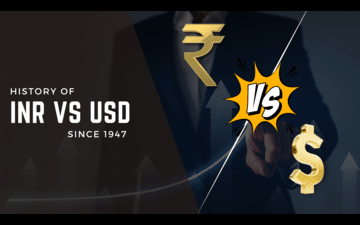
The Journey: US Dollar to Indian Rupee Exchange Rate since 1947 – History and Current Trends
Key Insights:
- Did you know the USD to INR exchange rate was 3.30 INR back in 1947? But currently the rate stands at ~84 INR. How did we get here? Read on to find out.
- Discover the USD to INR history and the discourse of exchange rates over the decades. What key events lead to INR’s depreciation, and what are the current trends?
We live in a globalized economy, where the notion of national boundaries has become more diluted with intense digitization. The conversations on international currencies and exchange rates are very normal nowadays not only among traders and business owners but international students and common folks who love to travel.
But have you ever wondered about the history of currency exchange rates? If so, then this blog is a must-read.
We will discuss how the exchange rate between the US Dollar (USD) and the Indian Rupee (INR) has evolved after India’s independence in 1947. This blog will talk about the key factors that have influenced this discourse of USD vs. rupee and the current trends impacting this duo.
Understanding the Basics of USD to INR Conversion
What is the USD to INR Exchange Rate?
The exchange rate of USD to INR represents the value of 1 USD to INR. This value or rate indicates the economic relationship between India and the United States, impacting trade, economic policies, and investments. The exchange rate of USD Vs Rupee has seen tremendous changes over the years, underlining the changes in the economic conditions and international relationships.
Here’s a breakdown of the same for your reference:
| Year | Exchange Rate (1 USD to INR) |
|---|---|
| 1947 | 1.00 |
| 1948 | 3.31 |
| 1950 | 4.76 |
| 1966 | 7.50 |
| 1975 | 8.39 |
| 1980 | 7.86 |
| 1990 | 17.50 |
| 2000 | 45.00 |
| 2010 | 46.67 |
| 2015 | 62.97 |
| 2018 | 68.47 |
| 2019 | 70.00 |
| 2020 | 74.18 |
| 2021 | 74.55 |
| 2022 | 77.00 |
| 2023 | 83.24 |
| 2024 | 83.89 |
Note: This table is updated till the 31st of August 2024, the values are subject to market fluctuations and may change.
How is the Exchange Rate Calculated?
Exchange rates are volatile and they are informed by various factors. The value of 1 USD to INR is determined by the following:
- Interest Rates: A higher interest increases the currency strength, attracting foreign capital because of the better ROI. However, lower interest rates weaken the currency. The RBI’s Monetary Policy Committee determines the interest rates in India.
- Inflation Rates: Inflation rates indicate a nation’s economic stability. A lower inflation rate showcases a stronger economy with purchasing power. Therefore, the currency of a lower inflation nation is valued more than the one with higher rates.
- Economic Stability: Economic stability attracts foreign investments, strengthening a nation’s currency. A nation’s economic health is measured by GDP growth, employment rates and political stability.
- Trade Balances: A nation’s trade balance (i.e., export vs. import) also impacts the exchange rate. A trade surplus (i.e., export > import) implies a strong currency, while a trade deficit weakens it.
Central Bank’s Role and Monetary Policy:
The RBI or central bank is critical in determining a nation’s currency value through monetary policy. RBI determines the interest rates, open market operations, and reserve amount influencing the supply and demand of the currency. They can also intervene in the foreign exchange market to ensure economic objectives (i.e., controlling inflation or boosting export) to stabilize their currency.
How Exchange Rates are Quoted?
- Direct Quote: The Base currency = Domestic currency. For, e.g., INR 83.17 per USD 1
- Indirect Quote: The Base currency = Foreign Currency. For, e.g., 1 USD per 83.17 INR
What’s a Credible Source for Checking the Currency Rates?
The RBI’s website publishes the official exchange rates periodically, whereas, you can also obtain the rates through Forex services providers, currency conversion websites, banks, finance websites or apps.
Historical Context: 1 USD to INR in 1947
The Indian Economy and Currency in 1947
The Indian economy post independence in 1947 was majorly agrarian with a high reliance on imports of essentials and limited industrial development. India needed to rebuild herself and it was not easy with challenges like poverty, food shortage and poor infrastructure.
However, to mark our true independence, India introduced the Indian Rupee (INR) as the official currency replacing the British Indian Rupee. In 1947, the INR was pegged to the British Sterling Pound (GBP). This was a common practice to stabilise intern
What Was the Value of 1 USD to INR in 1947?
In 1947, 1 USD to INR was valued at 3.30 INR. This rate was not based on market forces, but the Indian government set this to facilitate international trade to ensure India’s economic development.
How Has the USD to INR Exchange Rate Evolved Since Independence?
- Devaluation of the Rupee:
- 1966: In 1966 devaluation of INR happened due to a severe balance of payment crisis. This caused the exchange rate to jump from 1 USD=4.76 INR to 7.50 INR.
- 1991: India faced another devaluation in the early 1990s due to a severe economic crisis. The exchange was adjusted from 1 USD= 17.90 INR to 24.58, marking the liberalisation of the Indian economy.
- Liberalisation and Shift to Market-Determined Exchange Rate
- 1991: Due to the economic reforms introduced by the Indian government, the exchange rates finally shifted towards a market-determined system, enabling the rates to be impacted by market forces. This led to a depreciation in INR against the USD, which was impacted by inflation, interest rates, and economic stability.
- Impact of Global Events
- 2008 Financial Crisis: The global financial crisis made the exchange rates across the world volatile, including the USD vs. INR. The value of INR weakened due to global uncertainty and reduced foreign investment.
- Recent Global Economic Shifts: Many events including, the COVID-19 pandemic and geopolitical tensions have impacted the global exchange rate. The USD is still powerful against the INR due to global trade dynamics, interest rate differentials, and inflationary pressures.
- Current Trends: The USD vs Rupee exchange rate continues to fluctuate, influenced by global economic conditions, domestic policies, and market perceptions.
Key Factors Influencing USD vs INR
Economic Policies and Their Impact on the Exchange Rate
- Fiscal Policies: The fiscal policies, such as tax reforms and government spending, of the USA and India, directly impact the exchange rate. Say if the Indian government increases public spending it leads to economic development, strengthening the INR. However, high debt can weaken the currency.
- Monetary Policies: The RBI and US Federal Reserve are crucial in determining the interest rate policies, which impacts the exchange rates. If RBI increases the interest rates, it strengthens the INR by attracting foreign capital. And if the Federal Reserve increases USA’s interest rates, it enhances the value of USD dominated assets, which strengthens USD but weakens INR.
Inflation and Interest Rates: A Comparative Analysis
- Inflation Rates: Inflation rates in the US and Indian also impact the exchange rates. A higher inflation rate in India relative to the USA leads to depreciation of INR, as it decreases the currency’s purchasing power. On the other hand, lower inflation rates lead to INR appreciation.
- Interest Rates: The capital’s flow in a nation is determined by the interest rates set by the central banks. If US interests are higher than India’s, the capital flows towards US strengthening USD. However, if interest rates in India are higher than in the US, it will attract foreign investment strengthening INR.
Trade Balance
- Trade Deficit: A trade deficit can also damper the value of INR. If India imports more it exports, say from the USA, it leads to currency depreciation. The more a nation pays for its imports in foreign currency, the value of the latter increases.
- Export Performance: If the export performance is more, it can boost INR’s value with global demand for Indian goods and services increasing. Conversely, weak exports can cause currency depreciation.
Foreign Investments
- Foreign Direct Investment (FDI): A high FDI strengthens the INR every time investors convert USD to INR to invest in India. This increases the demand for INR, resulting in appreciation.
- Foreign Portfolio Investment (FPI): The inflow and outflow of FPI’s (i.e., stocks, bonds, and others) leads to short-term fluctuations in the exchange rate. For instance, large inflows strengthen the INR wherein outflows cause depreciation.
Political Stability and Government Policies
- Political Stability: Political stability is crucial for attracting FDI, which makes the currency stronger. Political uncertainty in India, for instance, (i.e, policy changes, social unrest, elections, etc.) can repel investors causing depreciation.
- Government Policies: Economic reforms and policies also determine a currency’s value. For instance, business-friendly policies can attract foreign investments compared to strict trade policies.
Global Events and Their Effects on USD vs INR
- Global Recessions: Global recessions can reduce the export demand from evolving markets like India, reducing INR’s value. Conversely, the USD is preferred more in such situations as it’s considered a safe haven currency.
- Geopolitical Tensions: Geopolitical tensions impact the global financial markets affecting the Dollar vs Rupee exchange rate. In events such as the Russia-Ukraine conflict, the USD often strengthens while INR weakens due to uncertainty.
Global Economic Conditions
- Global Economic Growth: Global economic slowdown or recessions impact exports from emerging markets like India, weakening their currency. However, accelerating global economic growth can boost the demand for exports, increasing INR’s value.
Speculation and Market Sentiment
- Investor Sentiment: Speculations and perceptions about future or present economic conditions are highly valuable in the currency market. Negative sentiments or outlook on the Indian economy can cause INR’s depreciation even if the fundamentals are strong.
- Currency Speculation: Traders tend to speculate the future movements of currency pairs, which can cause volatility in the USD to INR exchange rate. These speculations are based on market expectations instead of actual economic conditions.
Natural Disasters and Pandemics
Natural calamities or disasters like floods or earthquakes heavily disrupt the economy, reducing the inverter’s confidence, and it can lead to currency depreciation. For instance, the COVID-19 pandemic caused global economic disruption and impacted the exchange rates, including INR, as markets slowed down because of the uncertainty. They can make the exchange rates highly volatile.
Current Trends: US Dollar Rate in India
Analysing the Latest USD to INR Exchange Rate
The current exchange rate of 1 USD to INR stands at 83.96 (i.e., as of September, 3rd, 2024). The USD vs INR exchange rate has been fluctuating because of global economic conditions, Indian economic policies, and geopolitical events. The USD is favoured by investors still as it’s a safe haven for traders and investors, and INR’s value is dropping compared to the USD in the global market.
Here’s why:
- The USD is more powerful than INR because of their stand in the global economy and the Federal Reserve’s monetary policies (i.e., high interest rates) which is weakening INR.
- India’s inflation rate is ~6.50% which is higher than the United States, which stands at ~ 3%. A higher inflation has reduced the purchasing power, weakening the INR but strengthening the USD.
- India is running on a trade deficit, the imports are still more than exports, which puts pressure on INR reducing its value.
- India’s inflow of FDI has also reduced to USD 26.5 billion in FY2024 from USD 42.0 billion in FY2023. This has also impacted the INR’s value.
Predictions for the Future: Where is the USD to INR Rate Headed?
- Scenario 1: If the US economy grows stronger, hiking the interest rates, the INR may weaken further.
- Scenario 2: If global economic conditions learn to favour risky or emerging markets, then currencies like INR can rebound and re-establish capital flow.
- Scenario 3: If India’s economic policies and reforms favour growth-oriented nature, it could strengthen INR.
Impact of Recent Economic Events on Dollar vs INR
- Interest Rate Hikes by the Federal Reserve: The US Federal Reserve continued to raise the interest in the US to curb the inflation. While the RBI is cautious with interest rates to control inflation to support economic growth. This has led the INR’s value to drop, while the USD is strengthening.
- India’s Recent Budget Announcements: The FY2024 budget has laid more focus on infrastructure spending and social welfare programs, which has influenced investor sentiment. These initiatives could boost future growth, elevating the INR’s value.
- India’s Inflation and Monetary Policy: Due to the high inflation rate in India, the RBI has maintained tight monetary policies, which negatively impacts INR’s value.
- Trade Deficit and Oil Prices: India, a major oil importer, has been affected by the fluctuating global oil prices causing trade deficit and depreciating INR. Also, the ongoing trade relationship between India and the US can significantly impact the exchange rate.
- International Organization’s Role: The assessment of IMF and Work Bank on India’s economy, combined with their global economic forecast, greatly influences the market sentiments and with it the exchange rate.
Practical Tips for Currency Exchange
How to Get the Best Exchange Rates for USD to INR ?
Here are some practical tips to get the best exchange value for USD to INR:
- Monitor exchange rates continuously, using reliable sources, to identify favourable rates.
- Compare rates from different sources, including banks, Forex providers like Laxmii Forex, and online platforms.
- Avoid exchanges at airports, as they offer high rates. It’s smart to exchange currency at banks or Forex providers before travel.
- Use Forex cards if you are a frequent traveller. They are cost-effective and have perks like exchange rate lock-in features.
- Always check for any hidden charges such as service charge or commission, affecting the exchange rate.
Common Pitfalls to Avoid in Currency Exchange
- Ignoring exchange rate fluctuations could incur unfavourable rates. Keep checking market trends to avoid this.
- Not comparing and checking the spread (i.e., the difference between buy and sell rates) could lead to less favourable deals. Compare and check spreads offered by different providers to avoid spread.
- Exchanging a large sum at once could prevent better deals. Break down the sum and exchange at different times for better deals.
- Online options give better rates than physical exchanges. Opt for online providers for low fees and rates.
Why Laxmii Forex is Your Best Solution?
- We offer competitive rates in the market ensuring you get the best value for USD vs Rupee. Our Student Forex cards are ideal for internal students.
- Zero hidden fees enabling transparency with additional perks like travel insurance and others.
- We offer online services for seamless currency exchange. Our online platform is user-friendly, secure and fast.
- Our highly reliable expert helps you maximise your savings to avoid common pitfalls and solve your concerns.
Conclusion
Recap of the USD to INR Journey
Our USD to INR history revealed that there have been several ups and downs since 1947 reflecting India’s evolving economy. We started at a rate of 1 USD = 3.30 INR, which has depreciated over the years due to economic policies, inflation rate, trade relations, and global events.
Key events like the devaluation of the Rupee in 1966, economic liberalisation in 1991, and recent global conditions have shaped the discourse of the currency, leading to the current exchange rate of ~ 84-85 INR/ USD.
Final Thoughts on Managing Currency Exchange in a Global Economy
As we are living in an interconnected globalised economy, managing the exchange rate is crucial. Global inflation, interest rates and geopolitical events are influencing domestic currency value, pushing businesses and governments to stay informed. Falling back on experts like Laxmii Forex can help you stay informed and navigate international money transfers or transactions cost-effectively.
The highest ever USD to INR was recorded in August 2024, where 1 USD was valued at ~ 85 INR.
This is only possible if the INR faces significant depreciation in coming years due to high inflation, trade deficits and global events. However, this is just a speculation.
If 1 INR comes 1 USD, that would indicate the Indian economy has grown in strength and stability compared to the United States. However, given the current economic context, such a scenario is less likely.
1 USD to INR in 1947 used to be veiled at 3.30 INR.
Future predictions of Dollar to INR suggest continued fluctuations and volatility with a chance of INR depreciation based on inflation rates, monetary policies by RBI and Federal Reserve. Although, some experts anticipate INR may reach 90 INR per USD after weakening over the next few years.

